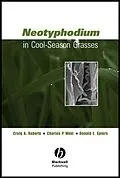Divided into logical easy-to-use sections, Neotyphodium in
Cool-Season Grasses is an up-to-date anthology of the latest
knowledge on the genus Neotyphodium. This thorough text
covers the molecular biology of Neotyphodium endophytes and
their effects on grass hosts, invertebrate and vertebrate
herbivores, and the plant communities in which they interact. The
expert editors also include information on the commercial uses of
endophytes in livestock and turf industries.
Researchers and teachers in grass research, extension, agronomy,
and animal toxicology, and university libraries with courses in
these subjects should not be without this important text.
Autorentext
Craig Roberts is the lead Editor and is State Extension Forage Specialist at University of Missouri.
Chuck West, University of Arkansas.
Don Spiers, University of Missouri
Klappentext
Divided into logical easy-to-use sections, Neotyphodium in Cool-Season Grasses is an up-to-date anthology of the latest knowledge on the genus Neotyphodium. This thorough text covers the molecular biology of Neotyphodium endophytes and their effects on grass hosts, invertebrate and vertebrate herbivores, and the plant communities in which they interact. The expert editors also include information on the commercial uses of endophytes in livestock and turf industries.
Researchers and teachers in grass research, extension, agronomy, and animal toxicology, and university libraries with courses in these subjects should not be without this important text.
Inhalt
Preface.
Section I: Current Trends in Neotyphodium.
1 Neotyphodium Research and Application.
1.1 Current Trends in the USA- Henry A. Fribourg and John C. Waller.
1.2 Current Trends in Europe- Iñigo Zabalgogeazcoa and Sylvie Bony.
1.3 Current Trends in New Zealand- Syd Easton and Brian Tapper.
1.4 Current Trends in Australia- K. F. M. Reed, C. J. Scrivener, K. A. Rainsford, and L. V. Walker.
1.5 Current Trends in Japan- Koya Sugawara, Takuya Shiba, and Masayuki Yamashita.
1.6 Current Trends in South America- Jose De Battista.
Section II: Molecular Biology of Neotyphodium.
2 Biosynthesis of Ergot and Loline Alkaloids- Christopher L. Schardl and Daniel G. Panaccione.
Ergot Alkaloids.
Loline Alkaloids.
3 Molecular and Genetic Analysis of Lolitrem and Peramine Biosynthetic Pathways in Epichloë festucae- Barry Scott, Carolyn Young, Aiko Tanaka, Michael Christensen, Brian Tapper, and Gregory Bryan.
Endophyte Synthesis of Bioprotective Metabolites.
Epichloë festucae as a Model Experimental System for Genetic Analysis of Endophytes.
Genetics and Molecular Cloning of a Peramine Biosynthesis Gene Cluster.
Molecular Cloning and Genetic Analysis of a Gene Cluster for Paxilline Biosynthesis.
Molecular Cloning and Genetic Analysis of a Gene Cluster for Lolitrem Biosynthesis.
4 Gene Discovery and Microarray-Based Transcriptome Analysis of the Grass- Endophyte Association -German C. Spangenberg, Silvina A. Felitti, Kate Shields, Marc Ramsperger, Pei Tian, Eng Kok Ong, Daniel Singh, Erica Logan, and David Edwards.
Biology of GrassEndophyte Symbioses.
Fungal Genomics.
Gene Discovery in EpicholoëNeotyphodium Endophytes.
Discovery of EST-Derived SSR and SNP Markers.
Fungal Transcriptomics.
Microarry-Based Transcriptome Analysis.
5 Molecular Genetic Marker-Based Analysis of the GrassEndophyte Symbiosis- Eline van Zijll de Jong, Kevin F. Smith, German C. Spangenberg, and John W. Forster.
Development and Characterization of SSR Systems.
Analysis of Intraspecific Genetic Diversity.
Phylogenetic Analysis.
Co-Genotyping of GrassEndophyte Symbioses.
Section III: Ecology and Agronomy.
6 A Hierarchical Framework for Understanding the Ecosystem Consequences of EndophyteGrass Symbioses- Marina Omacini, Enrique J. Chaneton, and Claudio M. Ghersa.
A Hierarchical Approach to Endophyte Impacts on Ecosystem Functioning.
Endophyte Effects at the Host Plant Level.
Endophyte-Driven Dynamics at the Neighborhood Level.
Endophyte Impacts on Community-Level Dynamics.
Future Challenges.
7 Biotic Responses in Endophytic Grasses- Alison J. Popay and Stacy A. Bonos.
Biotic Responses in Wild Grasses.
Invertebrate Responses in Forage and Turf Grasses.
Plant Pathogen Responses in Turf and Forage Grasses.
Multitrophic Interactions.
Factors Affecting Biotic Responses.
8 Abiotic Stresses in Endophytic Grasses- D. P. Malinowski, D. P. Belesky, and G. C. Lewis.
Drought Stress.
Light Stress.
Mineral Stress.
Novel Endophytes and Abiotic Stress Tolerance in Cool-Season Grasses.
9 Growth and Management of Endophytic Grasses in Pastoral Agriculture- David E. Hume and David J. Barker.
Endophyte Contamination in Pastures.
Sources of Contamination with Toxic Endophyte-Infected Perennial Ryegrass and Tall Fescue.
Factors to Consider in Selecting the Right Endophyte Option.
Section IV: Animal Toxicoses.
10 Managing RyegrassEndophyte Toxicoses- Lester R. Fletcher.
Confirming the Safety and Animal Productivity on AR1 Pastures.
Ryegrass Staggers in the Absence of Lolitrem B.
Managing Risk.
Minimizing the Impact of Endemic Endophyte in Grazing Systems.
11 Interaction between Thermal Stress...
